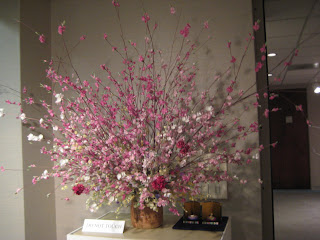by Maggie C

 3. Hanamayu uses waste cocoons which are dirty, damaged or have already been used for silk. Though often stained or misshapen, when dyed they display a beautiful variety of shades.
3. Hanamayu uses waste cocoons which are dirty, damaged or have already been used for silk. Though often stained or misshapen, when dyed they display a beautiful variety of shades.
 4. A petal shape is cut with the natural curve of the cocoon. Many thin pieces are peeled off of the cocoon.
4. A petal shape is cut with the natural curve of the cocoon. Many thin pieces are peeled off of the cocoon.
5. Layers can be peeled from the petal shape to make multiple petals, which are then glued together to form the flower. Layers are peeled from the cocoon in a similar manner to form the leaves.
The exhibit included arrangements that celebrated seasons. Here are two of the seasons…..
Spring
Small peach blossoms like these, which express the joy of the coming of spring, are displayed along with the Emperor and Empress dolls during the Doll’s Festival, on March 3rd.
Hi, I’ve really enjoyed reading the blog. Thanks so much for its creation, and everyone’s entries! It helps us stay connected during the garden’s winter closing, and provide more content to enhance our enjoyment of the garden.
So, here is my first small contribution to help with that connection and enhancement…..
I visited the Japanese Consulate in Washington DC this fall to view HANAMAYU, an exhibit of silk cocoon flowers. The flowers are so unique and beautiful, I think the blog readers would enjoy seeing the photos and hearing about the process.
Hanamayu is an original art form created by artist Tomike Sakai. From the Japanese hana, meaning flower, and mayu, meaning cocoon, hanamayu are timeless flower arrangements composed of silk.
The silk cocoon is a strong and lightweight material. The flower is created through a simple yet delicate process of gently twisting the silk cocoon between the artist’s fingers. The artist takes advantage of the natural shape of each cocoon.
The photos show the process
The silk cocoon is a strong and lightweight material. The flower is created through a simple yet delicate process of gently twisting the silk cocoon between the artist’s fingers. The artist takes advantage of the natural shape of each cocoon.
1. Silkworm caterpillars make silk cocoons during their process of metamorphosis. The cocoon is spun from a single silk filament stretching1300 meters long when unwound. The small silkworm entrusts his life to this thin thread.

2. The silk thread is made in Japan. Over the centuries, Japan has developed beautiful and distinctive silk threads. The kimono, the traditional dress of Japan and a symbol of Japanese culture, is woven from silk.
 3. Hanamayu uses waste cocoons which are dirty, damaged or have already been used for silk. Though often stained or misshapen, when dyed they display a beautiful variety of shades.
3. Hanamayu uses waste cocoons which are dirty, damaged or have already been used for silk. Though often stained or misshapen, when dyed they display a beautiful variety of shades.  4. A petal shape is cut with the natural curve of the cocoon. Many thin pieces are peeled off of the cocoon.
4. A petal shape is cut with the natural curve of the cocoon. Many thin pieces are peeled off of the cocoon. 5. Layers can be peeled from the petal shape to make multiple petals, which are then glued together to form the flower. Layers are peeled from the cocoon in a similar manner to form the leaves.
The exhibit included arrangements that celebrated seasons. Here are two of the seasons…..
Spring
Small peach blossoms like these, which express the joy of the coming of spring, are displayed along with the Emperor and Empress dolls during the Doll’s Festival, on March 3rd.
Many of the works on display were most recently showcased at the Shanghai World Exposition in June 2010 in both the Japan pavilion and the reception hall. Here is a link to a site: http://www.hanamayu.com/ It has better pictures.







No comments:
Post a Comment
Note: Only a member of this blog may post a comment.